SECONDARY BELT CLEANERS
Tecnipak’s secondary straight belt cleaner is placed right after the primary cleaner, underneath the head pulley, and is designed to clean fine particles off the conveyor belt. It is supported by pneumatic tensioners that work alongside the most durable cleaning blade in the industry so as to deliver the best cleaning quality, bar none. Additionally, for conveyor belts particularly long and fast, we’ve also developed a secondary parabolic belt cleaner that allows for focused cleaning performance.
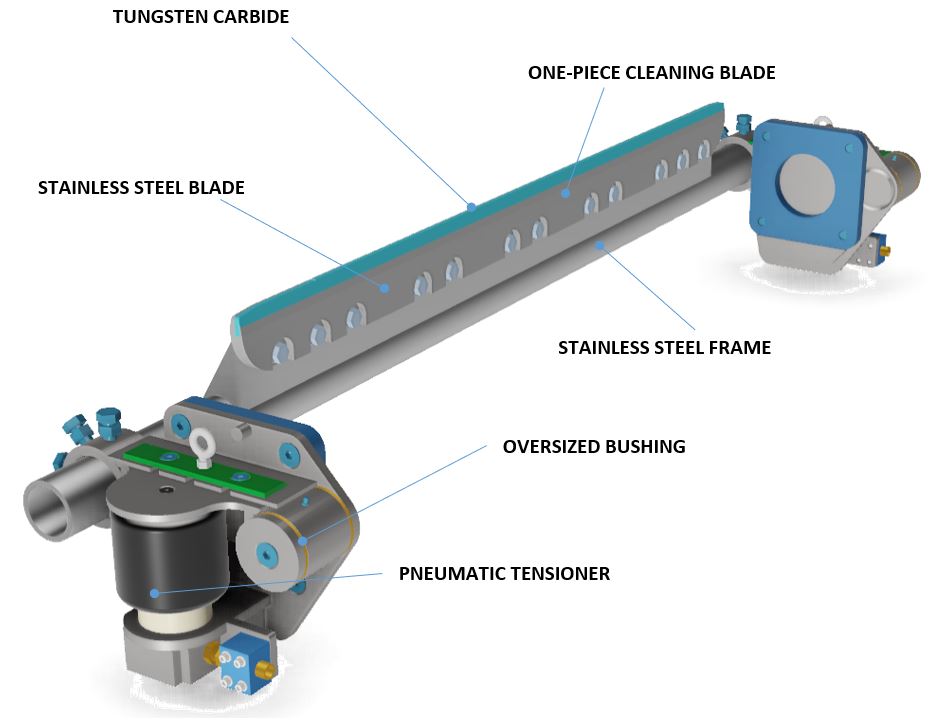
STAINLESS STEEL BLADE
Resistant to chemical attack, andprovides adequate support for the wear tip.
TUNGSTEN CARBIDE EDGE
With a backing made of ceramic for efficient and safe cleaning.
ONE-PIECE CLEANING BLADE
Prevents trapping of debris between segments, avoiding belt cover compromise.
STAINLESS STEEL FRAME
In 2 1/2’’, 3 1/2’’, or 4’’ pipe according to belt size, tonnage, and speed.
OVERSIZED BUSHING
Manufactured in stainless steel and bronze, and protected with lithium grease.
PNEUMATIC TENSIONER
Remote, precise, recordable, and repeatable adjustment. Self-compensating system for better cleaning performance.
• Safe for the conveyor belt. The one-piece cleaning blade avoids debris getting trapped, and its surface acquires a mirror-finish quality as it wears out so there is no danger of damaging the conveyor belt.
• Unique wear parts. Tungsten carbide with great hardness and toughness, of our own formulation, working with a black ceramic backing. This combination delivers exceptional and long-lasting cleaning performance.
• Toughest cleaners available. Tecnipak manufactures the frame of our secondary cleaners in 21/2’’, 31/2’’, and 4’’ pipe. They are the toughest belt cleaners available and because they are made from stainless steel, we can guarantee their performance even in the worst conditions.
• Pneumatic tensioners. The tensioners share the same pneumatic circuit so they are self-compensating (if one side is more demanded, the opposite side adjusts automatically to compensate). The cleaner’s adjustment is simple and because it can be narrowed down to a pressure reading, it is precise, reliable, recordable, and repeatable.
• Remote adjustment. The remote adjustment box can be installed in a safe place, away from the hazard zone, which allows the belt cleaner to be adjusted while the belt is running.
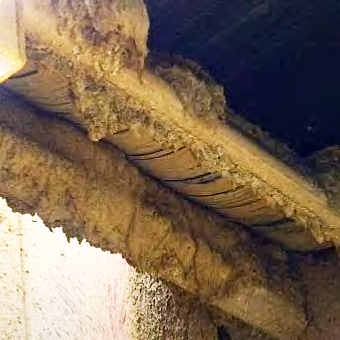
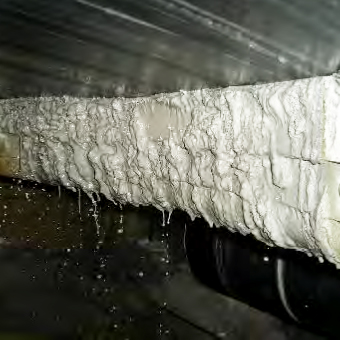
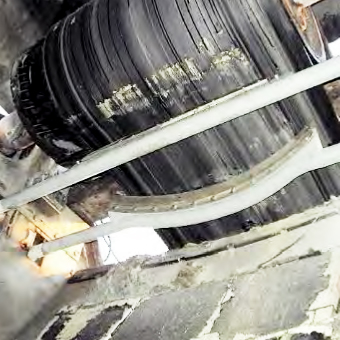
SPECIFICATIONS:
- Belt speeds up to 7,5 m/s (1.450 fpm)
- Belt widths from 600 mm up to 3.150 mm (24’’ up to 124’’)
- Pulley diameters from 400 mm up to 1.800 mm and above (16’’ up to 72’’+)
WORKING PRINCIPLE
The secondary straight belt cleaner is the main belt cleaning agent, and should be installed immediately after the point where the conveyor belt no longer touches the head pulley. It is at that spot that the maximum cleaning performance is achieved, while at the same time it is also the place where the removed material is most easily conveyed through the chute onto the next belt.
Tecnipak’s secondary cleaners, through their pneumatic tension system, keep the cleaning blade in contact with the belt at all times while exerting an even, constant force against it. The pneumatic springs deliver the pressure that creates the force against the belt, and because they share the same pneumatic circuit, they are self-compensating: when the working conditions change, both sides work together to adjust to the new condition. The force that the tensioners exert on the belt is simple to calculate since it is just a function of the pressure of the pneumatic springs (as can be seen in the adjacent chart), and this makes it easy to work with the cleaner because you only need a single parameter that is recordable and repeatable to set up the cleaner. The adjustment controls are to be installed away from the hazard zone, which allows for the cleaner to be adjusted on-the-fly, even if the belt is running.
The secondary parabolic belt cleaner is used on long and fast conveyor belts, where the conveyed ore sticks strongly particularly on the center of the conveyor belt cover because of the troughing angle of the idlers. Because of this, it is necessary to add an extra belt cleaner capable of performing a cleaning job focused on the center of the belt. Thanks to its parabolic shape and the pivoting motion of the tensioner, the parabolic cleaner concentrates the force on the center of its blade, effectively delivering a focused cleaning job where it is most needed.
CLEANING BLADES TECHNOLOGY
Our standard cleaning blades are manufactured with a stainless steel body onto which the wear elements are affixed. The wear tip is made out of tungsten carbide and black ceramic: the carbide offers hardness, toughness, and guarantees a sharp edge for great cleaning quality, and the ceramic complements the carbide by increasing the contact area, which enhances durability and makes for a safer operation.
Besides our standard carbide-ceramic blade, we offer other formulations such as a carbide-only blade, a ceramic-only blade, or a polyurethane-blade, the latter of which is fully manufactured in Shore 83 A hardness polyurethane, for use in belts with cover damage or mechanical splices. All of our blades are fixed to the frame with standard stainless steel bolts, for installation and removal without the need for special tools.
PRESSURE ADJUSTMENT SYSTEMS
Our cleaners are supplied with a remote pressure adjustment box that can serve up to two cleaners. To inflate the pneumatic tensioners, it is necessary to have either a pneumatic circuit available with sufficient pressure or a portable wireless air compressor (supplied as standard).
Alternatively, we can supply a box with a high-pressure cylinder that also serves up to two cleaners, thanks to which bringing the cleaners to working pressure after maintenance is almost instantaneous.
It also absorbs the small leaks inherent to every pneumatic system, thus decreasing the maintenance frequency. This system can also be connected to an online platform, so that the monitoring and operation of the scrapers can be done remotely.
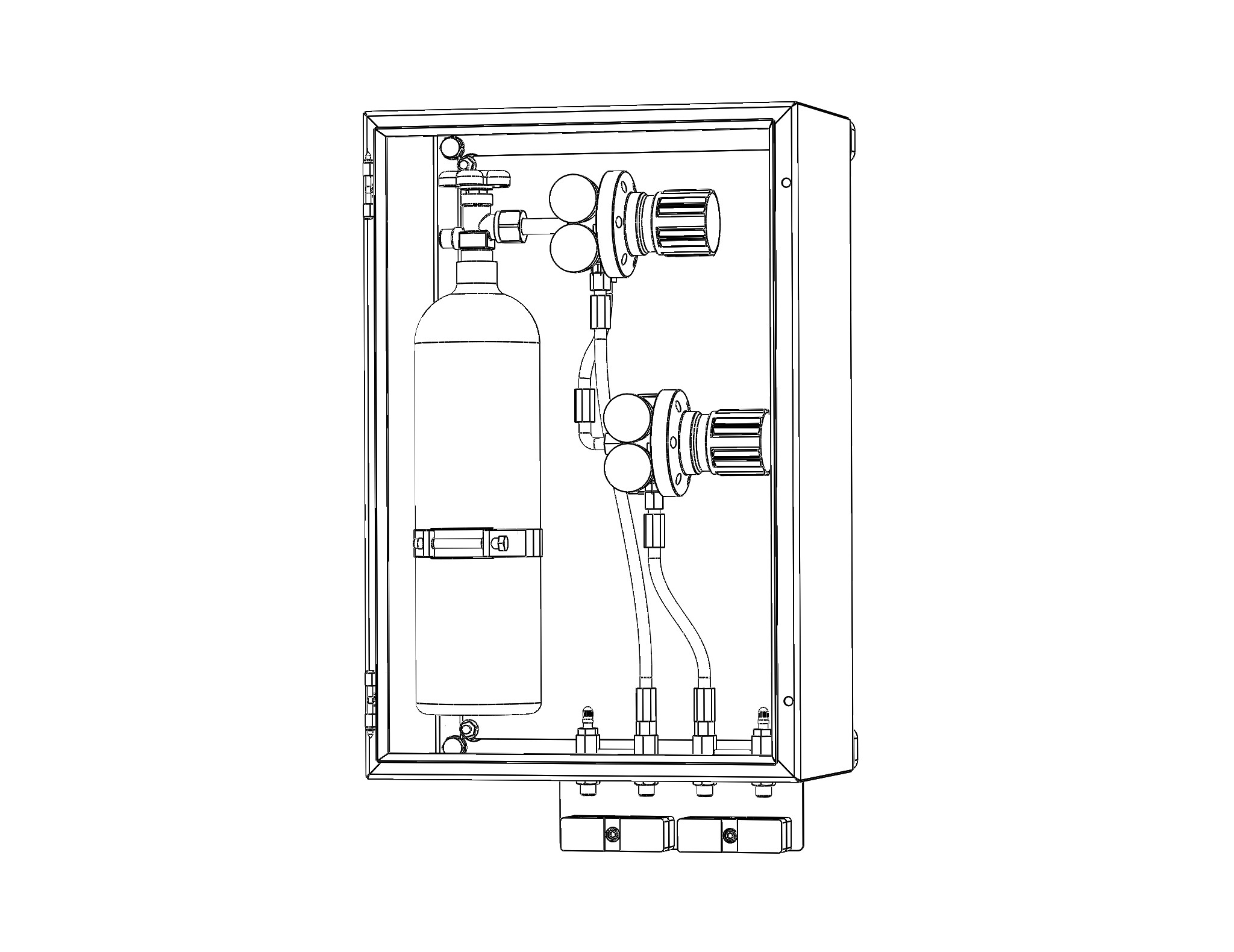
ADDITIONAL ALTERNATIVES
Tecnipak is continuously working on improving our scraper systems. We offer various alternatives to suit your particular working conditions, and we are experts in the design, development, manufacturing, and implementation of tailor-made solutions. Some of these solutions have become widely recognized by our customers, and we offer them as alternatives designed to suit specific requirements.
FULLY MECHANICAL TENSIONERS
For those customers who favor mechanical adjustment tensioners, Tecnipak has developed a tensioner with full mechanical operation. The frame is supported by a swing arm system which in turn slides along an ACME screw for regulation. Adjusting the tensioner is as easy as turning a nut and the swing arm system will slide up or down.
The tension is delivered by a square-in-square torsional elastomer that acts both as a spring and damper, so that the scraper will not achieve resonance when it is subjected to the vibrations inherent in a conveyor system.
The construction of the tensioner is in full stainless steel with the exception of the bushing of the thread, which is manufactured in brass to prevent the mechanism from getting stuck. All of the above guarantees that the tensioner is extremely reliable.
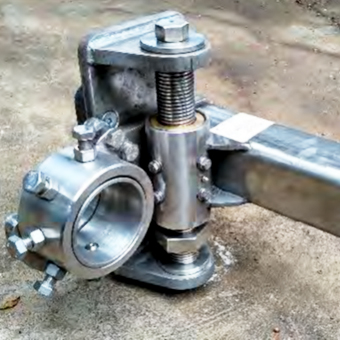
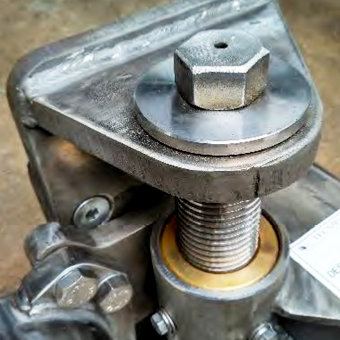
PROFILE BLADE
Tecnipak’s standard straight blade delivers stunning cleaning quality on most conditions; however, when the lining of the head pulley is very worn, when the belt shows heavy wear on its center, or when the belt has too much “memory" and is not straight enough after going through the head pulley, the standard straight blade may have problems delivering a good cleaning.
To correct this situation, Tecnipak recommends the use of a profile blade which compensates for these deviations, and ensures that the blade makes appropriate contact with the belt. The exact shape and rise of the profile will depend on the conditions of each conveyor system, so Tecnipak first gathers the necessary information from the conveyor system and then proceeds to make a tailored design and manufacture a specific profile blade for the application.
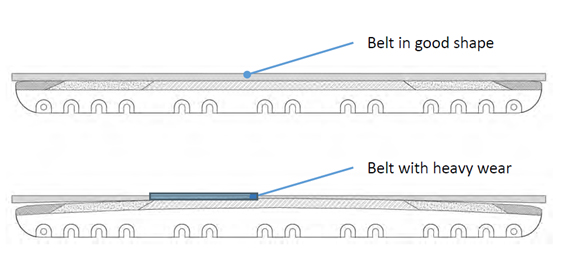
SPEED-CHANGE SECONDARY SCRAPER
For customers who value safety and efficiency, Tecnipak manufactures a speed-change secondary scraper that enables the customer to quickly and efficiently replace a worn blade.
Designed to save time and ensure a safer operation, this equipment prevents maintenance teams from getting inside the chute to change blades, where the working conditions are harder and with greater exposure to risk. Instead, after the tension has been removed, the scraper is released and pulled from the side of the chute and slides to a safe maintenance position. This whole maneuver is carried out from outside the chute, and allows for the maintenance staff to perform a blade replacement in a comfortable and safe manner.
Once the blade replacement is done, the scraper slides back into working position, is properly secured, and the tension is reapplied so that the scraper can continue its operation.
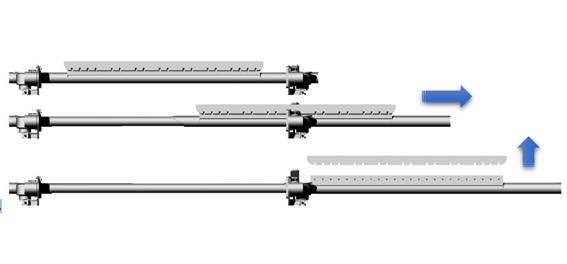
POLYURETHANE COATING
In places where the acidity in the conveyed ore is extreme, there is the possibility that even stainless steel does not offer adequate protection from corrosion. For these conditions, Tecnipak can coat the frames of its scrapers with a polyurethane coating. Thus the scraper’s frame gets an additional layer of protection against acid, increasing the life span of the equipment in these adverse conditions.
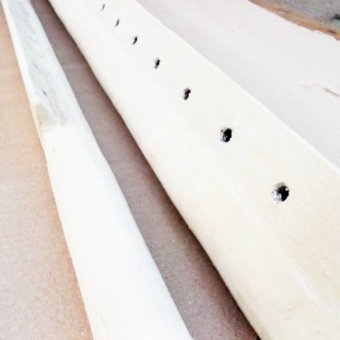
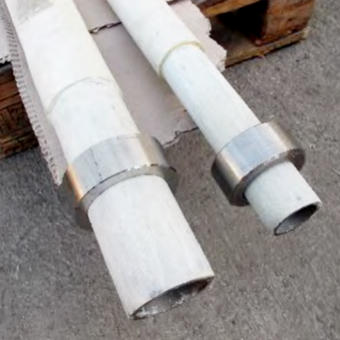
FAQs
Which blade size to use?
Each cleaner has its own blade. The length of the blade should match the width of the belt, as a shorter blade will not be able to clean the far ends of the belt and a longer blade will not wear out on its ends, which could damage the belt.
The belt is coming out clean on one side but dirty on the other. What can I do?
Uneven cleaning is the result of the cleaner being unevenly applied on the belt. Check that the movement of the cleaner is unencumbered and that its travelling path is clear. If that does not resolve the issue, check the position of the tensioners to ensure that the belt cleaner is properly aligned.
